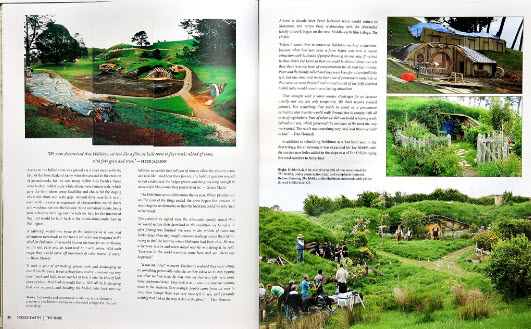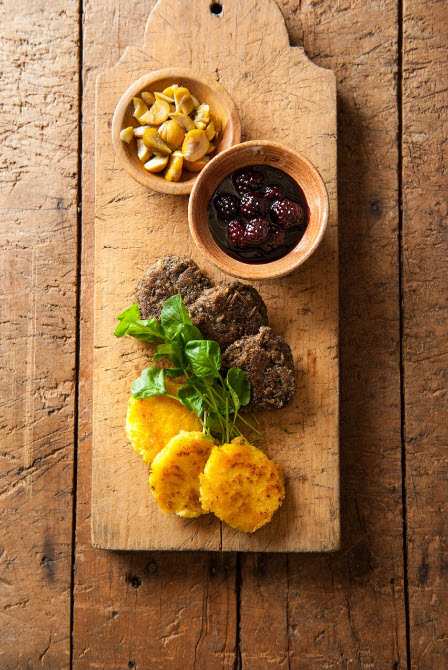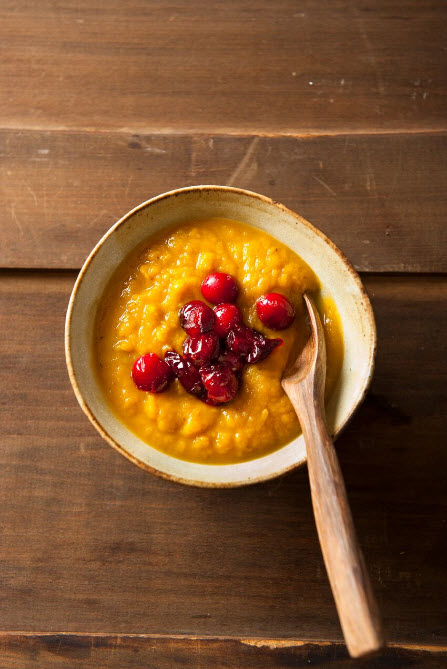Jordan Wright
November 2017
King Solomon’s Table ~ The Sioux Chef’s Indigenous Kitchen ~ Rasika – Flavors of India ~ Virginia Barbecue ~ The Potlikker Papers ~ Appalachian Appetite ~ The Faerie Handbook ~ Moonshine ~ Middle-Earth: From Script to Screen
If there’s a theme to this year’s crop of food and spirits books, it’s ethnically-driven, historic and authentic – with a dollop of fantasy. Like travelogues, they offer an authentic glimpse into the past.
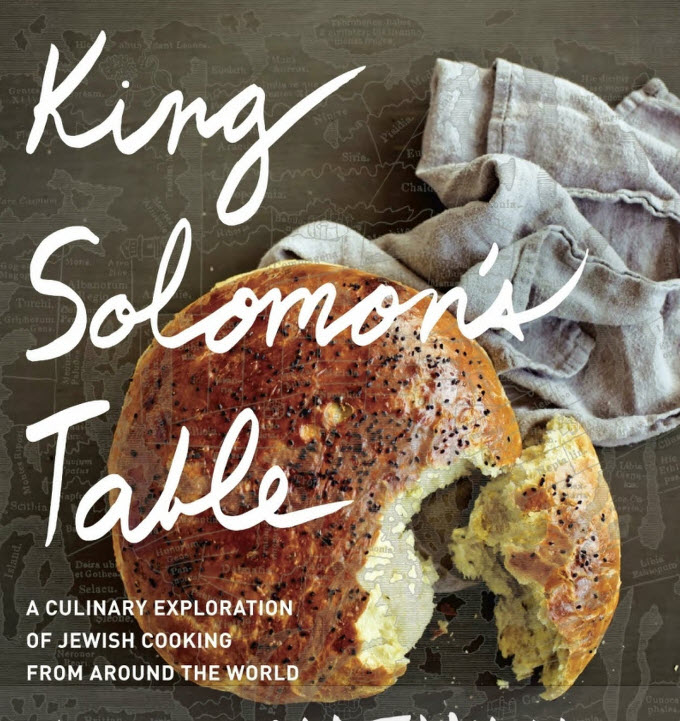
KING SOLOMON’S TABLE – A Culinary Exploration of Jewish Cooking from Around the World, Joan Nathan (Alfred A. Knopf 2018). This weighty and thoroughly comprehensive cookbook is Nathan’s most exciting to date. Edited by the late, much lauded Judith Jones with forward by Alice Waters, this compendium of forgotten recipes represents the many interpretations of the cuisine of the Jewish diaspora. As both historian and cook, Nathan, known as the grand dame of Jewish cookery, is relentless in her research. Through her extensive world travels into home kitchens and restaurants, she pries loose well-guarded, family recipes – many formulated with locally available ingredients. Her contextual and personal fore-stories to each recipe provide the kind of reading real cooks relish. www.aaknopf.com
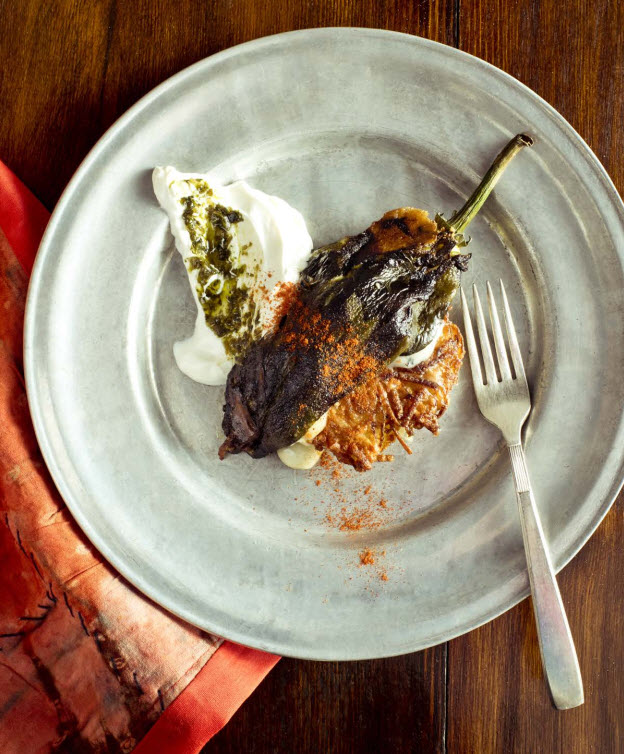
Green Chile Relleno Latkes
yield: 12 latkes
12 whole green chiles, such as Anaheim, Poblano, or Hatch
12 ounces (340 grams) white cheddar or Jack cheese, sliced width wise into 12 short pieces
2 pounds (1.11 kilos) russet or baking potatoes (about 3 large), peeled
1 medium onion, peeled
2 large eggs
B⁄d to V cup (30 to 55 grams)
panko or regular breadcrumbs or matzo meal
Salt and freshly ground pepper to taste
Vegetable or grape-seed oil for frying
1. Preheat the oven to 375 degrees and line a baking sheet with foil. Put the whole chiles on the baking sheet and roast for 40 minutes to an hour, flipping every 20 minutes, until the chiles are blackened all over. Let cool and then remove the stems and skin from each chili, leaving them as intact as possible. Then cut a slit almost the full length of each chili and carefully pull out the seeds. Put a piece of cheese inside each chili.
2. While the chiles are roasting, make the latkes, keeping the potatoes in cold water until ready to grate them.
3. Starting with the onions, alternately grate some of the onions in a food processor fitted with a steel blade or on the large holes of a large box grater and some of the potatoes on the smallest. (Doing it in this order will keep the
potato mixture from blackening.) When you have finished, put the potato and onion mixture into a clean dish towel and squeeze out the water into a medium bowl, allowing the potato starch to settle at the bottom. Carefully pour off the water, but leave the potato starch at the bottom of the bowl.
4. Once the liquid has been drained, put the potato mixture back in the bowl with the potato starch that has accumulated in the bottom. Add the egg, the breadcrumbs or matzo meal, and salt and pepper to taste and mix well.
5. Heat an inch of oil in a frying pan. Drop about 2 heaping tablespoons of mixture for each latke into the skillet and fry for a few minutes, turning
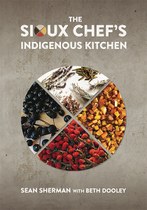
THE SIOUX CHEF’S INDIGENOUS KITCHEN – Sean Sherman with Beth Dooley (University of Minnesota Press 2017). Famed Oglala Dakota chef, Sean Sherman, brings his years of experience foraging game, fish and wild ingredients for authentic Native American fare to his first cookbook. I have been vicariously following Sherman’s nationwide nose-to-tail dinners on Facebook throughout the year, especially a six-course dinner at the James Beard House.
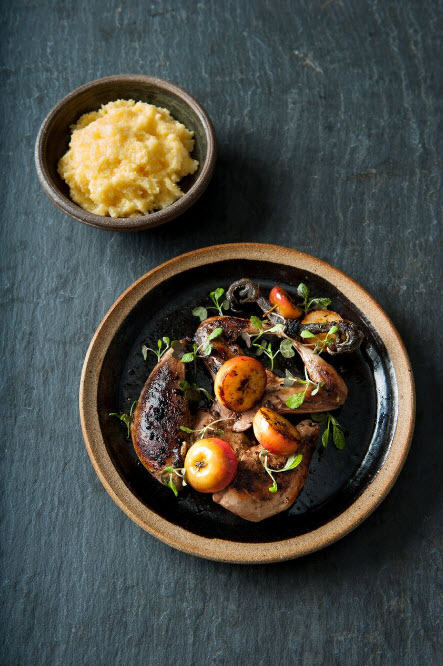
Maple–Juniper Roast Pheasant
Čhaŋháŋpi Tiktíča na Ȟaŋté úŋ Šiyóša Čheúŋpapi
Serves 4 to 6
When I was growing up on the Pine Ridge Reservation, we stocked our freezers with pheasant and grouse. We’d see them darting across the dirt roads into the dry brush. They were as common as the red-winged blackbirds perched on the fence posts.
Overnight dry brining seasons and helps this especially lean bird to become tender and succulent. The technique also works with grouse and guinea hens.
2 small pheasants
1 tablespoon coarse salt
2 tablespoons maple sugar
1 teaspoon sumac
1 teaspoon crushed juniper
¼ cup Rendered Duck Fat, page 105, or sunflower oil
1 cup fresh cranberries
½ cup Corn or Turkey Stock, page 170, or vegetable stock
3 tablespoons maple vinegar
2 griddled apple halves for garnish (optional)
The day before, rinse the pheasants and pat dry with paper towels. To dry-brine, generously season with the salt, maple sugar, sumac, and juniper. Place on a roasting pan or deep plate in the refrigerator, uncovered, overnight.
Preheat the oven to 500°F. Place the pheasants breast side up in a medium roasting pan. Rub a generous amount of the duck fat under the skin of the birds and over the outside of the skin. Put half the cranberries into the cavity of the pheasants and spread the rest in the pan. Pour the stock and vinegar into the roasting pan. Roast for 15 minutes. Reduce the heat to 350°F and baste the pheasants with the pan juices. Continue roasting until the skin is crisp, the juices run clear, and a meat thermometer inserted in the thigh reaches 155°F, about 30 to 45 more minutes. Allow to stand at least 10 minutes before carving.
Carve and drizzle with the pan juices before serving with the griddled apples.
Substitute 2 tablespoons cider vinegar and 1 tablespoon maple syrup for the maple vinegar.
For the griddled apples, slice the apples in half horizontally, brush with a little sunflower or walnut oil, and griddle cut side down in a hot skillet or frying pan until lightly browned, about 3 to 5 minutes.Rendered Duck Fat
Carefully remove all the skin and fat from the duck breasts, cutting close to, but not touching, the meat. Once the fat and skin are removed, cut into 1-inch chunks. Place the skin, with its fat, into a heavy-bottomed skillet or Dutch oven. Set the pan over low heat and slowly cook, stirring occasionally, until the skin has crisped and its fat has changed to liquid, about 45 minutes. With a slotted spoon, remove the crisped skin (cracklings) and drain them in a bowl lined with paper towels. Allow the liquid fat to cool to room temperature, then strain through a fine-mesh sieve lined with cheesecloth into a bowl or a clean glass jar.
Corn Stock
Save the corncobs after you’ve enjoyed boiled or roasted corn on the cob or you’ve cut the kernels for use in a recipe. Put the corncobs into a pot and cover with water by about 1 inch. Bring to a boil and partially cover. Reduce the heat and simmer until the stock tastes “corny,” about 1 hour. Discard the cobs. Store the stock in a covered container in the refrigerator or freezer.
Fish, Game, Meat Stock
We make stock with just about everything in the larder, including vegetables (except greens) and bones (even smoked fish bones). Essential seasonings:
Juniper
Sage
Cedar
MintJuniper and cedar are aggressive flavors, so add seasoning with a light touch. You can always add more later on. Then add enough water to cover the ingredients completely and set over a low flame until the stock is flavorful. Cooking time will vary depending on the amount of liquid and the ingredients, but most stocks require cooking at least 2 to 3 hours.
Wild Rice Cakes
Psíŋ Aǧúyapi Sáka na Hoǧáŋwičhašašni Ašótkaziyapi nakúŋ Waȟpé Skúya Yužápi
Makes about 4 to 6 cakes
These are our go-to cakes for breakfast, as a snack, and as the base for a well-seasoned bison braise or duck. They’re especially good topped with smoked fish and our bright lemony Sorrel Sauce, page 64. Make them tiny for an appetizer or big for dessert slathered in maple-berry sauce.
The recipe for these couldn’t be simpler. It’s just overcooked wild rice, pureed into a thick dough. We like to stir in a little cooked wild rice for texture. Once shaped, these will keep several days in the refrigerator, so feel free to make them ahead. Leftovers may be re-crisped in a low oven until warmed through.
2 cups cooked wild rice, page 81
About 3 cups water
Pinch salt
Generous pinch maple sugar
3 to 4 tablespoons sunflower oil or more as needed
Put 1½ cups cooked wild rice and water into a saucepan, reserving ½ cup. Place over high heat, bring to a boil, and reduce the heat to a simmer. Cook until the rice is very soft and the water has evaporated. Drain. In a food processor fitted with a steel blade, puree the rice into a sticky dough. Place the dough into a medium bowl and work in the salt, sugar, and the remaining cooked rice.
Scoop out a scant ¼ cup dough for each patty and shape to rounds about ½ inch thick. Heat the oil in a heavy skillet and brown the patties about 5 to 8 minutes per side until lightly browned. Transfer the patties to a baking sheet and place in a warm oven until ready to serve.
Squash and Apple Soup with Fresh Cranberry Sauce
Wagmú na Tȟaspáŋ Waháŋpi nakúŋ Watȟókeča T’áǧa Yužápi
Serves 4 to 6
This rich, flavorful soup has a creamy texture without cream. We use the small, tart crab apples that grow in backyards and along the borders of farm fields.
2 tablespoons sunflower oil
1 wild onion, chopped, or ¼ cup chopped shallot
2 pounds winter squash, seeded, peeled, and cut into 1-inch cubes
1 tart apple, cored and chopped
1 cup cider
3 cups Corn Stock, page 170, or vegetable stock
1 tablespoon maple syrup or more to taste
Salt to taste
Sumac to taste
Cranberry Sauce, page 108, or chopped fresh cranberries for garnish
Heat the oil in a deep, heavy saucepan over medium heat and sauté the onion, squash, and apple until the onion is translucent, about 5 minutes. Stir in the cider and stock, increase the heat, and bring to a boil. Reduce the heat and simmer until the squash is very tender, about 20 minutes. With an immersion blender or working in batches with a blender, puree the soup and return to the pot to warm. Season to taste with maple syrup, salt, and sumac. Serve with a dollop of Cranberry Sauce.
Recognition for his decades-long efforts as chef and educator has been given by National Public Radio, Guardian UK, Saveur and the New York Times. Sherman has just started a non-profit, NATIFS.org (or North American Traditional Indigenous Food Systems). In an email from last week, Sherman shared his exciting news. “We are actively fundraising, searching for an Executive Director, and looking for the building that will be an Indigenous Food Hub and the heart of the non-profit.
The building will house an indigenous restaurant under the non-profit that will be open to the public and used as a live training center to teach restaurant skills. The building will also have an education and research component called, The Indigenous Food Lab, which will offer classes and training on all parts of the indigenous food system curriculum we’ve been working on. We are expecting to find a building this year and begin building out as soon as possible.” In addition, he will open an indigenous focused restaurant in the new Waterworks Project in downtown Minneapolis along the river by the historic Stone Arch Bridge, the site of many spiritual and historic places for the Dakota people. www.upress.umn.edu
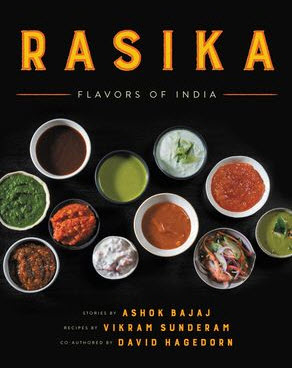
RASIKA – FLAVORS OF INDIA – Ashok Bajaj/Vikram Sunderam/David Hagedorn (Ecco 2017). The combination of mega-restaurateur Bajoj, James Beard Award-winning chef Sunderam and food writer and author David Hagedorn affords a back-of-the-house peek into a restaurant that has become a sensation. The book has tons of gorgeous photos and recipes for vegetarians (and vegans too) including one of the restaurant’s most popular dishes, Palak Chaat. The book methodically leads the reader into explanations and descriptions of exotic Indian spices, followed by a section of cocktails and ‘mocktails’ and a myriad of recipes, many from the restaurant’s signature dishes. A former chef and recipe writer for the Washington Post, co-author Hagedorn writes in a clear and detailed style to make these delicious recipes easy to accomplish. www.eccobooks.com
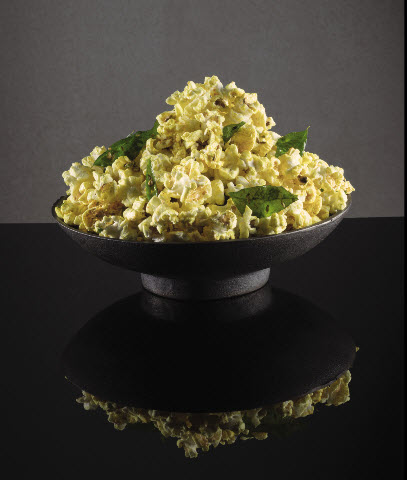
MASALA POPCORN
Vegan
Makes about 6 cups
This popcorn, which we offer with drinks in Rasika’s cocktail lounge, is a take on the indian snack chiwda, a sweet and savory mix often made with fried poha (puffed rice), dried fruit, nuts, spices, and herbs. There are many ways to make it and people add whatever they like—maybe corn flakes, coconut chips, chana dal. It’s a mainstay during Diwali, much like you’d have Chex Mix during the American holiday season.
If you don’t want to use the microwave popcorn, make it the old-fashioned way, following directions on the package of kerneles to make 6 cups of popcorn.
One 3.2 ounce back microwave popcorn
(Movie theater butter flavor or plain and salted), popped according to package directions)
2 tablespoons canola oil
1 teaspoon fennel seeds
1 teaspoon coriander seeds
1 teaspoon cumin seeds
1 teaspoon coarsely chopped fresh Thai green Chili
10 (1 ½ inch) fresh curry leaves (more if smaller), whole or cut crosswise into thin strips.
¼ teaspoon Kashmiri chili powder
¼ teaspoon ground turmeric
1/8 teaspoon asafetida
¼ teaspoon sugar
¼ teaspoon salt
Place the popcorn in a large bowl.
In a small saucepan, heat the oil over medium-high heat until it shimmers. Add the fennel seeds, coriander seeds, and cumin seeds and let them crackle. Stir in the green chili, curry leaves, Kashmiri chili powder, turmeric, and asafetida. Pour the mixture over the popcorn. Add the sugar and salt and stir or toss to coat evenly. (Keep tossing as you eat it to distribute the spice.)
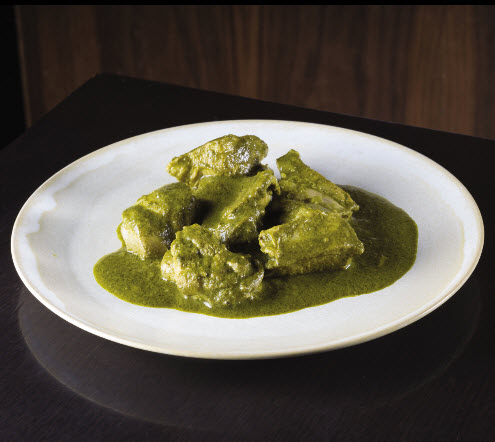
Chicken Green Masala
Serves 4
This is a riff on a Goan dish called chicken cafreal, which was brought to Western India by the Portuguese from their African colonies. (Cafreal is a Portuguese word meaning “in the African way.”) In the traditional recipe, chicken, whole or cut into bone-in pieces, is marinated in spicy green masala paste and then roasted. We decided to use the same ingredients and flavors, but to cut the chicken into bite- size, boneless pieces. This makes a much cleaner presentation and provides plenty of sauce for rice and bread. Despite its spiciness, or maybe because of it, Chicken Green Masala is one of the most popular dishes at Rasika.
Cooking the chicken uncovered rather than covered after the cilantro puree is added helps maintain its brightness.
For optimal flavor, make this dish many hours in advance, preferably the day before, and reheat it, although the sauce’s color will become darker.
Cilantro Puree
4 cups coarsely chopped cilantro, including stems
1 cup packed mint leaves
10 medium fresh Thai green chilies, coarsely chopped
½ teaspoon ground turmeric
½ cup fresh lemon juice
1 cup water
Chicken
1 tablespoon green cardamom pods
1 teaspoon whole cloves
2-inch cinnamon stick, curshed
2 tablespoons canola oil
1 cup finely chopped yellow onion
2 pounds boneless, skinless chicken (breast and/or thigh), cut into 1-inch cubes
½ teaspoon ground turmeric
1 ½ teaspoons salt
1 cup sunweetened coconut milk
Cucumber Raita (page 269), for serving
Plain Basmati Rice (page 217) and Naan (page 247), for serving
- MAKE THE CILANTRO PUREE: In a blender, combine the cilantro, mint, green chilies, garlic, turmeric, lemon juice, and water and blend on high speed to make a smooth puree. Run the blender for several minutes; the finer and smoother the puree, the better.
- MAKE THE CHICKEN: In a spice grinder, grind the cardamom pods, cloves, and cinnamon stick into a powder.
- In a heavy- bottomed pot or Dutch oven, heat the oil over medium- high heat until it shimmers. Sauté the onion, stirring frequently, until soft but not browned, about 3 minutes. Stir in the chicken, turmeric, and salt. Cover the pot and parcook the chicken for 5 minutes, stirring occasionally. Stir in the cilantro puree, coconut milk, and cardamom/clove/cinnamon powder and bring to a boil. Cook uncovered for 5 minutes, stirring occasionally, until the chicken is cooked through.
- Serve with cucumber raita, rice, and naan.
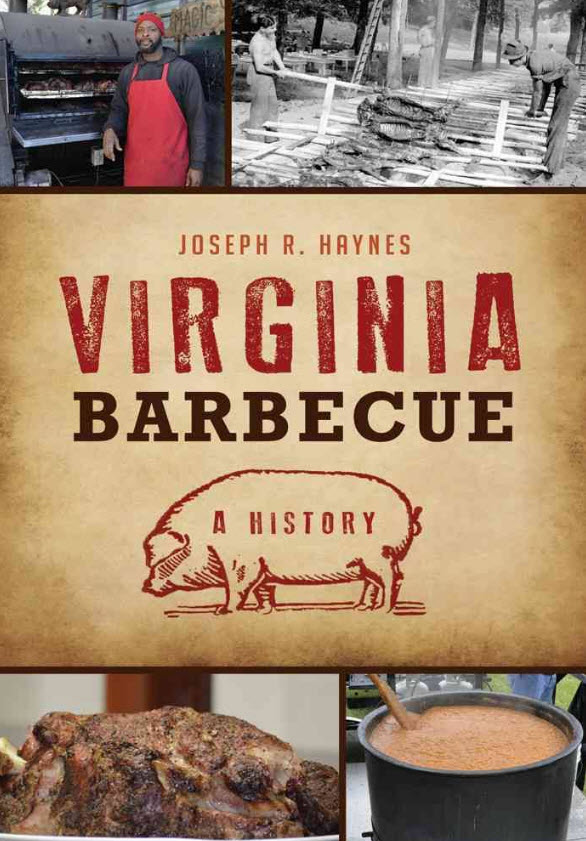
VIRGINIA BARBECUE – A HISTORY – Joseph R. Haynes (American Palate 2016). A member of the Patawomeck Indian tribe of Virginia, Haines is the consummate researcher you wish you had time to be. Combing through dusty archives and pouring over old recipe books, he proves that barbecue originated in Virginia with Native Americans. The book is rich with historic detail including old illustrations, archival photographs and posters advertising barbecue suppers. A must for backyard grillers looking for Virginia bragging rights. www.historypress.net
Wesley Jones, born enslaved in 1840, was a South Carolina barbecue cook. In 1937, at the age of ninety-seven, he shared his old southern barbecuing technique and recipe:
Night befo’ dem barbecues, I used to stay up all night a-cooking and basting de meats wid barbecue sass [sauce]. It made of vinegar, black and red pepper, salt, butter, a little sage, coriander, basil, onion, and garlic. Some folks drop a little sugar in it. On a long pronged stick I wraps a soft rag or cotton fer a swap, and all de night long I swabe dat meat ’till it drip into de fire. Dem drippings change de smoke into seasoned fumes dat smoke de meat. We turn de meat over and swab it dat way all night long ’till it ooze seasoning and bake all through.
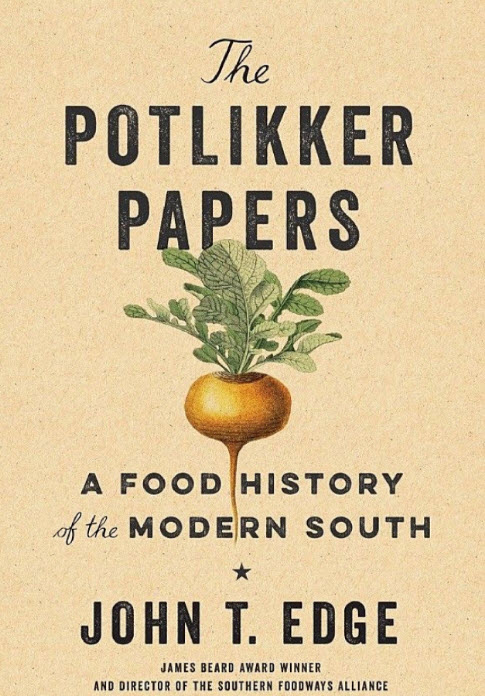
THE POTLIKKER PAPERS – A FOOD HISTORY OF THE MODERN SOUTH – John T. Edge (Penguin Press 2017). It’s not a simple matter to tie up the history and culture of food in the South, but Edge keeps us riveted throughout. As director of the Southern Foodways Alliance and James Beard Award-winner, Edge understands the politics and prose of Southern cooking. “‘Potlikker’ was an early euphemism for the polyglot of racial politics that is the South,” he explains. He gives props to the early pioneers of modern Southern cooking and tells tales from Fanny Hamer to Kentucky Fried Chicken founder Harland Sanders and Paul Prudhomme. A regular contributor to Garden & Gun magazine and winner of the James Beard Foundation’s M. F. K. Fisher Distinguished Writing Award, Edge proves that Southern cooking is what makes America great! www.thepenguinpress.com
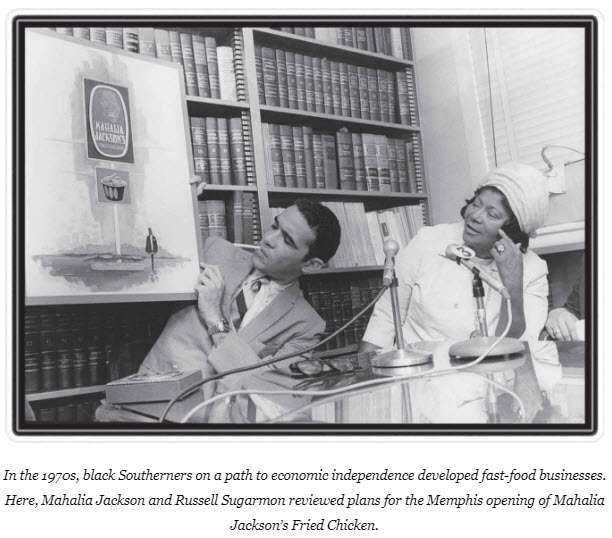

APPALACHIAN APPETITE – RECIPES FROM THE HEART OF AMERICA – Susi Gott Séguret (Hatherleigh Press 2016). Séguret’s French culinary school education informs her love for the wild and foraged ingredients from the hills of Appalachia and Madison County. In this heartwarming love story of all things Appalachian, she shares recipes from well-known Southern chefs and old-time song lyrics from her deep love of the region she calls home. www.hatherleighpress.com
Tiller’s Molassie Cake
Katie Hoffman, Historian
Ingredients:
2½ cups all-purpose flour
1½ teaspoons baking soda
1 teaspoon salt
1 teaspoon cinnamon
1 teaspoon cloves
½ teaspoon powdered ginger
For the Sorghum Mixture
1 cup “molassie” (sweet sorghum syrup)
½ cup melted butter (the original recipe calls for Crisco)
½ cup sugar
2 eggs
Preparation:
Preheat oven to 375°F and grease and flour a 9×13-inch pan. In a large bowl, whisk together the dry ingredients. Add the sorghum mixture and stir. Then, at the last minute, stir in 1 cup boiling water. The batter will be very thin. Pour it into the greased and floured cake pan. Bake for about 30 minutes. Use a cake tester to determine doneness. Do not overbake. (Or if you do, make the butterscotch sauce and no one will ever know!)
For the Butterscotch Sauce
Ingredients:
1½ cups brown sugar
2/3 cup corn syrup
4 tablespoons butter
¾ cup evaporated milk
Preparation:
Bring sugar, syrup, and butter to a boil, then let cool. Add the milk slowly, stirring constantly. Pour evenly over the top of the warm cake. Much of the sauce will sink in, but you will get a beautiful shiny glaze over the top.
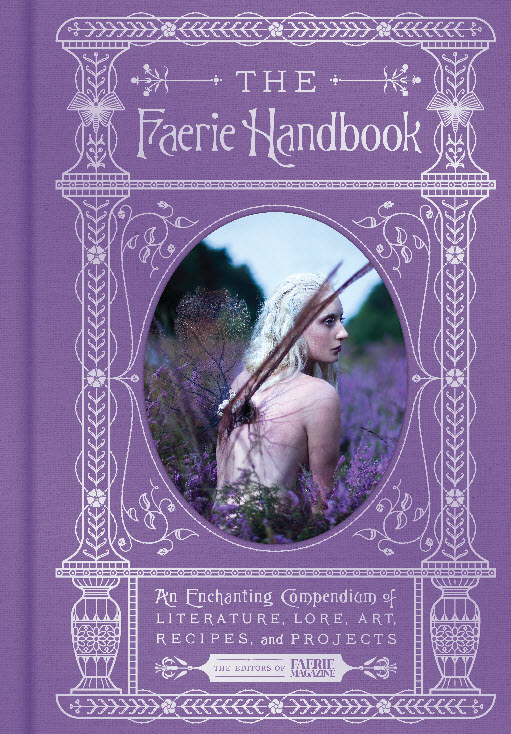
THE FAERIE HANDBOOK – AN ENCHANTING COMPENDIUM OF LITERATURE, LORE, ART, RECIPES AND PROJECTS – (from the Editors of Faerie Magazine 2017). Faerie lore is not something that was on my radar until this lovely book landed on my desk. Written by editor-in-chief Carolyn Turgeon and the editors of Faerie Magazine, one of Barnes & Noble’s top-selling lifestyle magazines. Who knew? They have a readership of 28,000. This lovely lavender linen-wrapped book traces the history of fairies from literature to pop culture. Featuring a well-curated array of vintage and contemporary fine art and photography, fashion pieces, essays, do-it-yourself projects and holiday recipes. www.harperdesignbooks.com
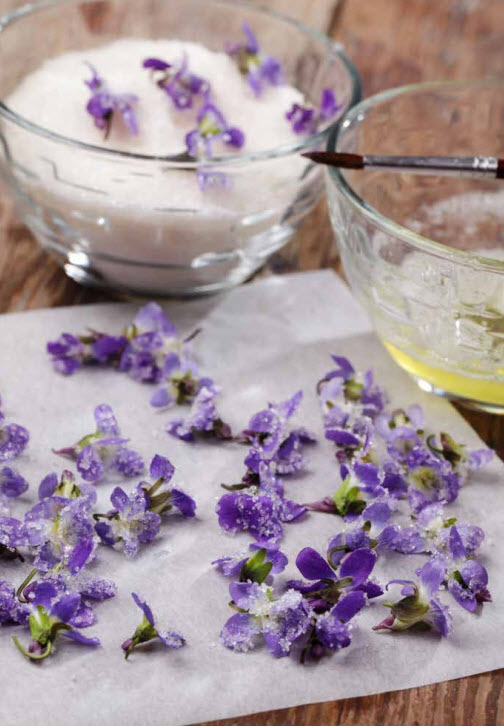
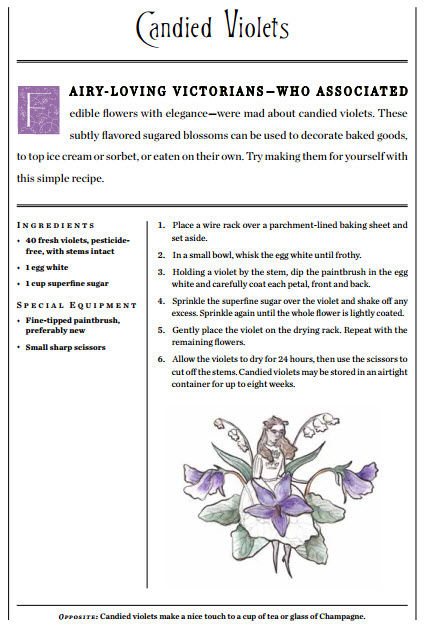

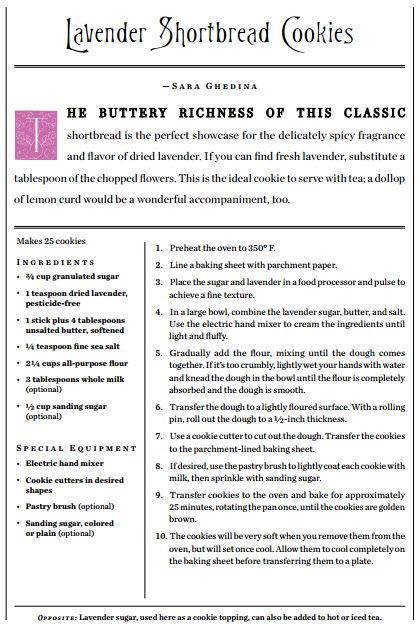
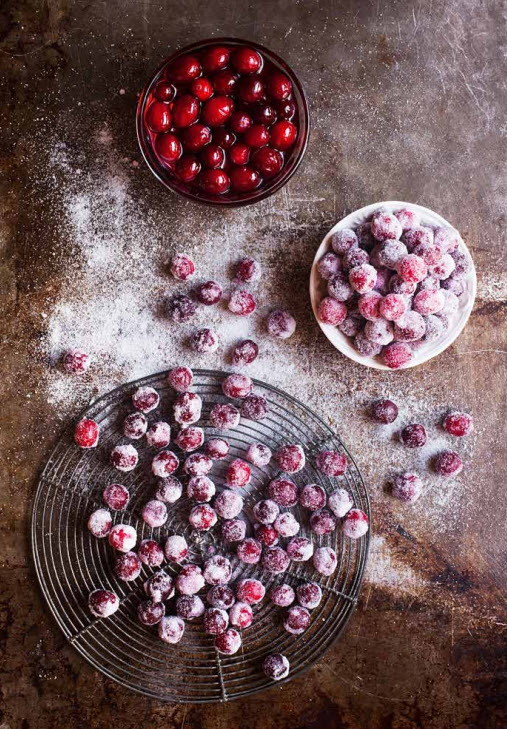
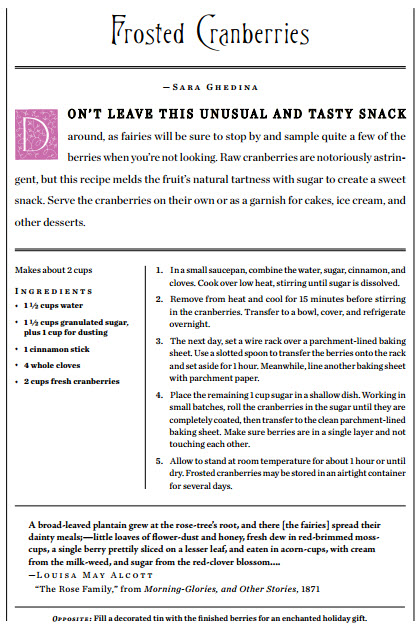
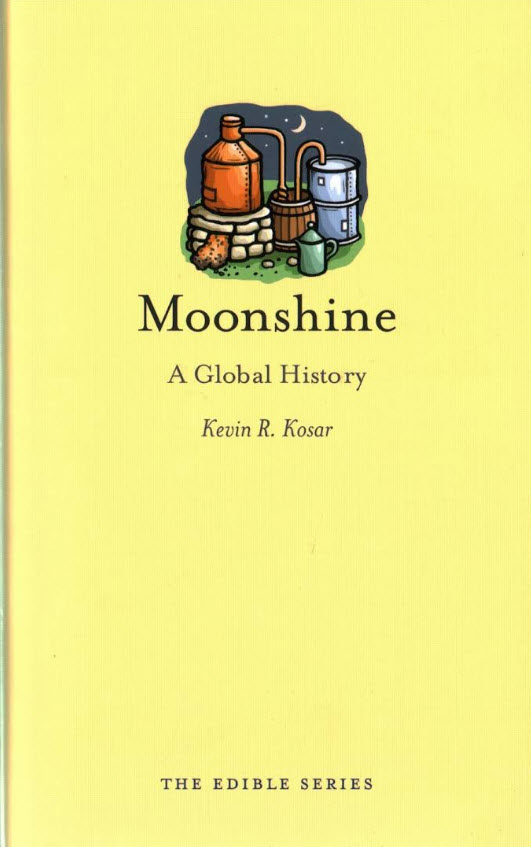
MOONSHINE – A GLOBAL HISTORY – Kevin Kosar (The Edible Series, Reaktion Books, UK 2017). A Washington, DC alcohol policy wonk, Kosar counts this as his second book on the topic of spirits. His first foray into writing about his favorite topic was Whiskey. Illustrated with photographs of early American backwoods stills, caricatures of moonshiners and illegal booze busts, Kosar proves that moonshine is a global phenomenon begun by ancient civilizations. Here we learn of the rum runners, gangsters, mountaineer moonshiners and Prohibitionists who peppered the industry when it was illegal and untaxable. A fun read with cocktail recipes for the uninitiated, Kosar writes, “Many recipes were developed in the U. S. during Prohibition to mask the taste of poorly made moonshine.” Thankfully we’ve come a long way from those days. www.reaktionbooks.co.uk

MIDDLE-EARTH: FROM SCRIPT TO SCREEN – Building the World of the Lord of the Rings and The Hobbit – Daniel Falconer (Harper Collins 2017). For the fantasy-minded, this massive 512-page book is an ode to the original set of “friendly folk”, Peter Jackson’s crack, creative team and art directors, who conceptualized the impossible bringing J. R. R. Tolkien’s magical trilogies to the big screen. It’s the consummate compendium for those eager to glimpse behind the scenes and learn the secrets behind the cinematic making of Middle Earth – its innovative visual and special effects that lead to its garnering 17 Academy Awards. Insider glimpses into set decoration, costume design, locations and character development, include hundreds of photos and concept illustrations from the closed set. Ring Trilogy geeks will learn how sets were built brick by brick and digitally pixel by pixel, including how multiple shooting units functioned. www.harperdesignbooks.com
